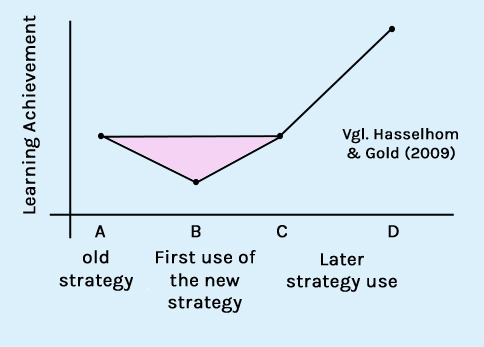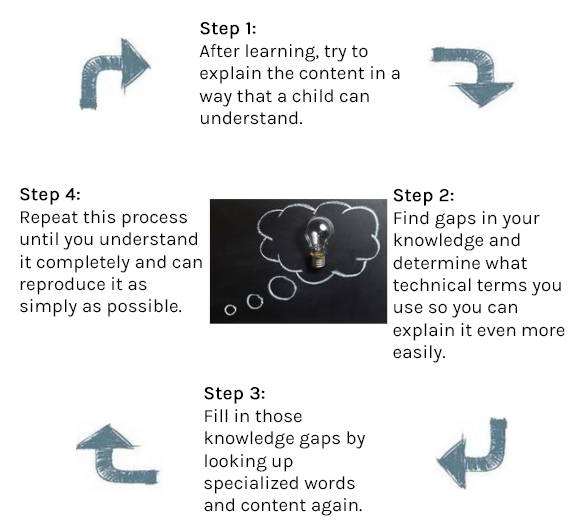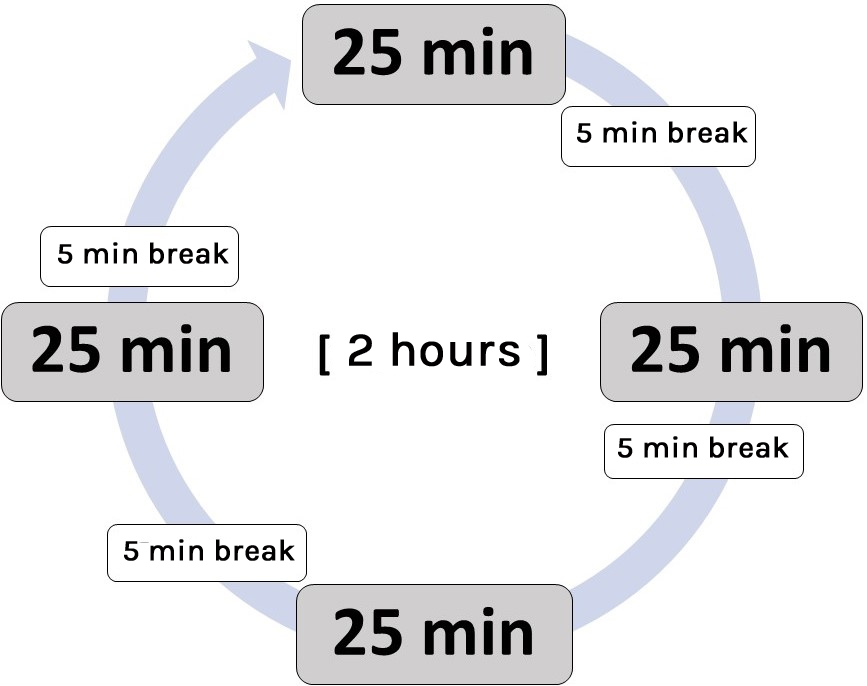1 Overview
Course content
In this course you will learn 7 successful methods and strategies to improve your learning habits. Bring structure to your learning style and achieve your goals!

Previous knowledge
No previous knowledge is necessary. Be open to new strategies, because it takes time to change your learning behavior.
Course duration
About 60 minutes.
2 Motivation
Your learning style does not show success? You sometimes do not know what or how to learn?
Every person automatically acquires learning strategies. Often, texts are only read through repeatedly or tasks are worked through according to cooking recipes.
Hard truth: This type of learner that you seem to be and therefore can do some things well or not, does not exist.
Humans are creatures of habit. They are good at what they have been doing for a long time, so you get the feeling that everyone is a different type of learner. Be brave to try new strategies that bring you more variety and also success!

Sometimes learning can be a real pain in the neck.
3 Motivation - The valley of tears
Your previous strategies will no longer work at some point. This is completely normal and depends on what or how much you learn.
Trying a new learning strategy can be very frustrating if it doesn't work the first time. You fall into a kind of "valley of tears" and are tempted to try old strategies again.
Familiarize yourself with new strategies and practice them over time!

The valley of tears in self-regulated learning. After learning performance initially decreases when trying a new strategy, it increases again with repeated use and shows success. Source from German translation
4 The 7 learning strategies at a glance
Whether it's just a matter of memorizing or learning content in depth - there are one or more suitable learning strategies for every situation.
Strategy
| Strengths |
|---|---|
| |
| |
| |
| |
| |
| |
|
5 The Feynman Method
The Feynman method is a helpful way for you to determine if you really understood content.
When learning, you often feel that the content sounds logical, but you still encounter difficulties when working through the tasks in each case. Most of the time, this is because you haven't really understood the topics. To promote understanding, this method will help you:

Graph with the four steps to implement Feynman's method. Source from the german content.
6 Memorization strategies for learning by heart
Memorizing content is sometimes so difficult for us because our short-term memory can only absorb limited information. With memory strategies, information can be bundled, linked or simplified so that learning is easier and information can be stored in the long term.
Chunking
Try to remember the sequence of numbers .
Not so easy, is it? But it is remarkable that your brain automatically tries to form packages and you remember something like Your brain forms so-called "chunks", i.e. large pieces, which reduces the sheer amount of information.
These chunks can be of any size, but should be divided in a meaningful way. One possibility in this case:
A very clever choice of chunks would be the one shown in the picture. The series of numbers that just contained 16 pieces of information can be broken down to 2 pieces of information.

Chunks do not always have to be related to numbers. Information of all kinds, as well as texts, can be divided into chunks (e.g. meaningful sections). This associates certain information with each other and makes it easier to remember.
Mnemonic bridges
Indiscriminate information can be associated with each other by mnemonic bridges. Very well known is this one:
In English, the 7 coordinating conjunctions are For, And, Nor, But, Or, Yet, So = FANBOYS.
Include the environment
Have you ever listened to music while learning? Did you later remember what you learned while listening to the music, or the other way around: did you remember the music while thinking about the learning content?
Our brain links all information. Multisensory learning deals exactly with this theory that all senses are involved.
The more extensively a situation or environment is enriched (perhaps with a certain song or when calculating a task one always drinks the same tea), the more information is linked to what is learned. There are then different ways to access the learning material, which makes recall much easier.
Different factors of your environment can burn in with what you learn:
Music, a particular song during a learning activity
A movement
A picture, like a photographic memory
A taste, from a drink that you drink along the way.
Insignificant details
Some information can be expanded to be learned as much more central than is actually necessary.
Suppose you want to memorize:
Germany reached the semi-finals of the 2014 World Cup.
You can either remember this as the sole piece of information, or you can expand it with some details: In 2014, Germany defeated the host Brazil by a fabulous 7:1 and won the final against Argentina, which made them world champions.
The information that Germany was in the semifinals is much more central, as it is also a logical assumption that Germany was world champion.
Expand information that stands on its own. Such information is like dead ends in your brain and not connected to anything else. However, make sure it's not so much information that your subject matter fades into the background.
7 The learning diary
Have you ever written a diary? Experiences are easier to remember and bring back memories as soon as they are read through again.
The learning diary is no different, because everything learned is reported in your own words. Not like a story, but in a continuous text.

Learning diary guide
The learning diary is a continuous text in which the following questions are answered:
What did I understand well?
What was particularly surprising for me, what was not?
What have I not yet understood?
Where can I get answers to my questions?
A learning diary is not a list of topics covered in class. It is meant to deal with the subject matter so that connections are made or strengthened.
Examples of a learning diary entry
Today in physics class we learned about free fall. The teacher dropped a ball and a feather and the ball fell faster. After that we calculated with formulas.
I managed to do some of the calculations, but not the difficult tasks, which was a bit frustrating.
Here, only the course of the lesson was presented. This does not stimulate the mind very much.
Today we talked about free fall. Until now, I thought heavy objects fell faster, which is why it was surprising to hear my teacher say, "Without the resistance of air, a ball and a feather would fall at the same rate."
I understood well that air plays a role in falling, but not yet exactly what she meant. Next lesson I might ask her again or search the internet for an explanation.
You can see here that connections are made and gaps in understanding are identified and addressed by you.
8 The Pomodoro method
With the help of this method you will get a clear time management. The Pomodoro method works as follows:
Work on one piece of content for 25 minutes. It is best to set yourself a precise goal so that you can work with focus.
After that, take a 5-minute break, during which you strictly distance yourself from learning, preferably even away from your desk.
Repeat these points for the period in which you want to study.

Procedure of the Pomodoro method for 2 hours of learning
For example, within 6 hours of time, you can study 5 hours concentrated.
For the Pomodoro Method to work properly, make sure that you...
... always set clear goals for yourself, such as "I want to understand the concept of ... "
... do not work during breaks.
... work through tasks one after the other, so that you don't linger over old tasks.
9 Improve text comprehension with "active reading"
The next time you read a text where content is important to remember, try using the "Active Reading" method:
Read text once through
Put the text away
Summarize: Write down everything that comes to mind.
Compare: Take the text again and compare it with your summary.
Add to and improve your summary and put it in a meaningful order.
Repeatedly improving a knowledge gap focuses your attention on the part of the text that seems difficult to remember. By reproducing the text, you uncover gaps in your knowledge better than if you just read.
To repeat does not mean to understand. If the content of the text is technically difficult to understand, other strategies must be added.
10 Increase your productivity with the Ivy Lee method
Do you feel like you haven't accomplished anything after hours of studying? Learning could always be more productive. Some steps to take to achieve a more productive work mindset are pretty obvious:
Put your smartphone away to avoid distractions.
Get drinks, food, etc. at your desk to avoid getting up frequently.
Don't listen to music that's too upbeat and distracts you from your flow.
This is nothing new. However, what has been proven to steal time and is often not clear is multitasking. This is where the Ivy Lee method helps.
Ivy Lee Method Guide
Formulate your goals/tasks and put them in writing (Attention: Write a maximum of 6 tasks on the list!)
Set priorities (arrange your tasks in an order from 1-6)
Complete the first task in such a way that there is absolutely nothing left to do.
Check: Are the priorities still correct?
Do the second task, etc.
The fact that working through tasks is productive is also unsurprising. What lies behind it, however, is some research that has found: Multitasking takes more time than normal singletasking. There can be exceptions, especially when tasks are interwoven.
Doing two tasks at the same time takes longer than doing both tasks one after the other.
A task is not finished until there is absolutely nothing left of it. As soon as there is a rest of the task to be done, your attention is on it and not on your next task. This is what the "Attention residue theory" says.
11 Learning languages with the Birkenbihl method
Do you have a text in a foreign language that you want to translate? Or do you want to improve your listening comprehension? The Birkenbihl method prohibits mindless learning of vocabulary and gives you a learning strategy with which foreign languages can be learned comprehensibly.
The 4 steps of the Birkenbihl method
Decoding
Active listening
Passive listening
Learning Activities
Decoding a text describes the literal translation of a text. With the help of a dictionary, you can "decode" the individual words, learning the structure and style of the foreign language.
Do not translate the text of the foreign language as it would make sense in English.
Be as literal as possible in the wording!
In active listening, the text is read aloud in the original language and you read along at the same time. The text is meant to help you understand words that you would otherwise not understand while listening. Once you can understand each word without the help of the text, you are ready for the third step.
Passive listening describes listening to the foreign language without reading at the same time. This is the best way to train your listening comprehension and you can even do other activities at the same time. Here, formulations, speech melody are learned much more intensively.
Use learning activities to continue learning. Possible activities are:
Writing in the foreign language (a dialogue, a story, a letter or report)
Speaking (act out situations, like in a restaurant or bakery)
